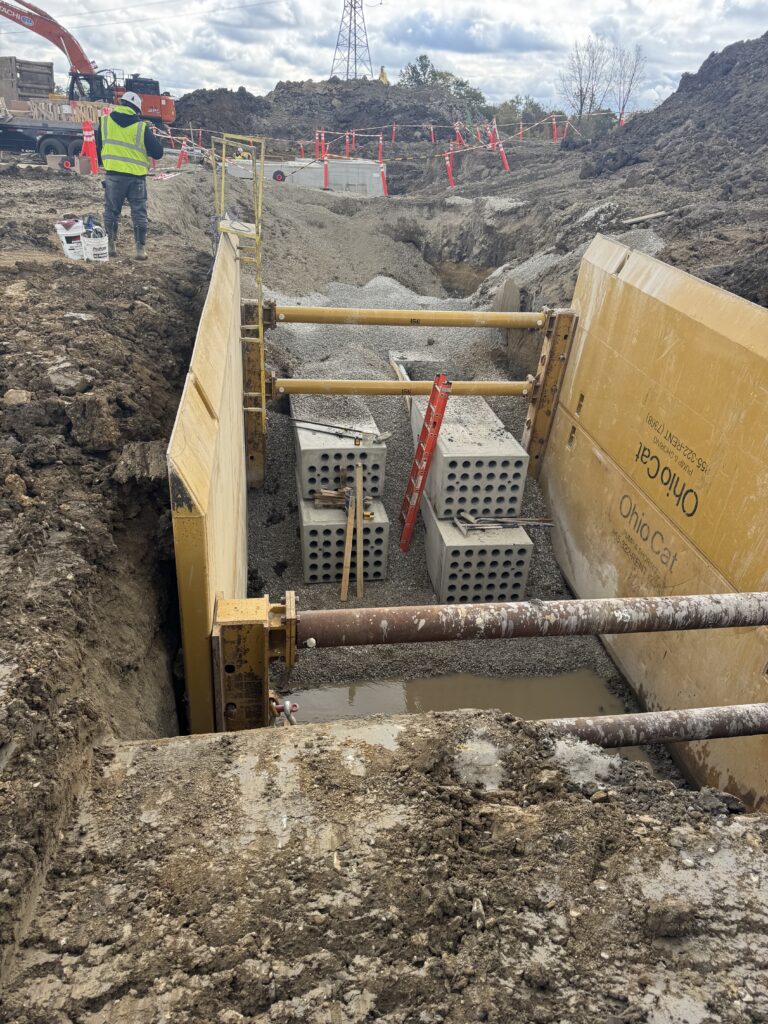Data-center construction has always been about scale and reliability. Now it’s about sustainability too. The largest cloud and industrial owners have set aggressive carbon-reduction and renewable-energy targets. Every component — from structural steel to underground duct banks — is being measured, reported, and benchmarked. The pressure isn’t coming from marketing teams; it’s coming from shareholders, regulators, and grid operators.
DBO helps contractors and owners meet those standards from the ground up.
The ESG Mandate, Translated to the Jobsite
Environmental, Social, and Governance (ESG) goals drive new procurement rules and design requirements:
- Carbon reporting: Owners must quantify embodied carbon in every yard of concrete and mile of conduit.
- Renewable-energy alignment: On-site infrastructure must support low-carbon power distribution and future renewable connections.
- Resource efficiency: Projects are scored on material waste, trucking mileage, and energy consumption during construction.
- Resilience & safety: Safer, repeatable installation methods support the “social” side of ESG reporting.
For builders, sustainability isn’t a separate checklist — it’s now embedded in schedule, budget, and compliance.
What Low-Carbon Construction Really Looks Like
Meeting ESG goals doesn’t happen by changing specs on paper; it happens by changing how infrastructure is built. DBO’s precast process delivers measurable reductions where field methods can’t:
| Impact Area | Traditional Cast-in-Place | DBO Precast Approach |
| Embodied Carbon | High cement content, over-pours, site waste | Optimized low-cement mix, within a 15–25 % reduction range vs NRMCA average (verified EPD data) |
| Transportation Emissions | Multiple ready-mix and haul trucks | Rail-fed supply chain with up to 75 % lower ton-mile emissions (AAR data) |
| Waste & Rework | Form lumber, leftover concrete, patch pours | Reusable forms, precision batching, zero over-pour waste |
| Energy Use on Site | Extended cure times, equipment idling | Factory curing, one-day trench closeout |
(Sources: NRMCA EPD v3.2 2023; Association of American Railroads 2018.)
These efficiencies reduce embodied CO₂ while maintaining schedule certainty — aligning construction execution with owner sustainability audits.
Sustainability = Cost, Reliability, and Reputation
For hyperscale programs, sustainability isn’t just a reporting metric — it directly affects:
- Total cost of ownership: Lower-carbon materials often mean optimized quantities and less rework.
- Schedule reliability: Precast shortens exposure windows, reducing weather-related downtime.
- Operational credibility: Owners are graded by investors on ESG progress; verified low-carbon supply chains protect those scores.
Every avoided truck trip and every saved yard of concrete reduces both carbon and contingency cost.
How DBO Fits the Owner’s Sustainability Model
DBO’s process aligns naturally with large-scale sustainability frameworks:
- Documented transparency – Environmental Product Declarations (EPDs) available for standard DBO mix designs.
- Measured performance – Mix designs tested to NRMCA methodology and independently verified.
- Local sourcing and rail logistics – Minimizing trucking distance and fuel usage.
- Efficient installation – Same-day backfill reduces equipment hours and energy use.
That’s why forward-looking developers are specifying precast systems like ours — not to check a box, but to prove their projects are built cleaner, faster, and safer.
The New Definition of Sustainable Infrastructure
Tomorrow’s data centers will be measured not just by uptime, but by how efficiently they were built.
DBO’s vertically integrated, low-carbon manufacturing process gives contractors and owners quantifiable results today:
- Lower embodied carbon (up to 25 % reduction compared with NRMCA average).
- Fewer emissions from transport and rework (rail ≈ 75 % lower ton-mile CO₂ per AAR).
- Safer, faster field execution.
- Clear documentation for ESG reporting.
Sustainability isn’t a future requirement — it’s already written into the RFP. DBO makes sure underground infrastructure helps you meet it.



